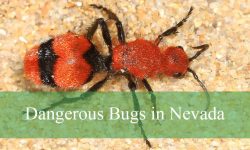Ants are among the most common insects found in Missouri, but some species are far more than a nuisance. Biting ants, in particular, can cause painful encounters and even allergic reactions in humans and animals. Understanding which species bite and where they live can help you stay safe both indoors and outdoors.
Missouri’s warm summers and diverse habitats provide an ideal environment for many ant species. From aggressive fire ants that sting with venom to carpenter ants that bite with powerful jaws, each species has unique behaviors, nesting habits, and ways of defending their colonies. Knowing how to identify these ants can make it easier to manage infestations before they spread.
In this guide, we will explore 15 types of biting ants found throughout Missouri. You will learn how to recognize them by appearance, understand their behavior, discover where they nest, and find practical ways to prevent them from invading your home or yard.
Common Types of Biting Ants Found in Missouri
Red Imported Fire Ant (Solenopsis invicta)
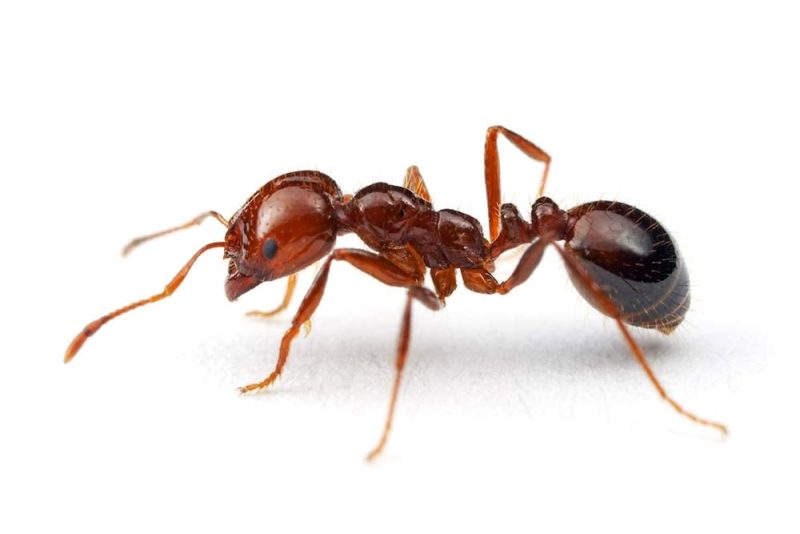
The Red Imported Fire Ant is one of the most aggressive and notorious ant species found in Missouri. These ants are small, ranging from 1/8 to 1/4 inch long, with a reddish-brown body and a darker abdomen. They are easily recognized by their fiery coloration and the large mounds they build in open areas such as lawns, pastures, and roadsides. Fire ants are well adapted to warm climates, and their colonies can contain hundreds of thousands of workers led by one or more queens.
When disturbed, these ants attack in large numbers, delivering painful stings that cause a burning sensation and pustules on the skin. Their venom contains alkaloid toxins that can trigger allergic reactions in sensitive individuals. Unlike other ants that rely solely on biting, fire ants use both their mandibles to grip and their stinger to inject venom repeatedly. This aggressive defense behavior makes them one of the most dangerous ant species to humans and animals in Missouri.
Fire ants are omnivorous, feeding on a wide range of foods including insects, seeds, and plant material. They are opportunistic predators and scavengers, often raiding other insect colonies and feeding on dead animals. Around human settlements, they may also invade pet food bowls, garbage bins, and compost piles. Their foraging trails are usually active during warm months, especially after rainfall.
Their nests are typically built in open, sunny areas with moist soil, and they can thrive in lawns, agricultural fields, and along roadsides. These mounds can reach up to 18 inches high and have multiple entry holes. In Missouri, fire ants are most commonly found in the southern parts of the state, where warmer temperatures favor their survival. Control efforts often involve bait treatments and mound drenches to manage their spread.
Allegheny Mound Ant (Formica exsectoides)
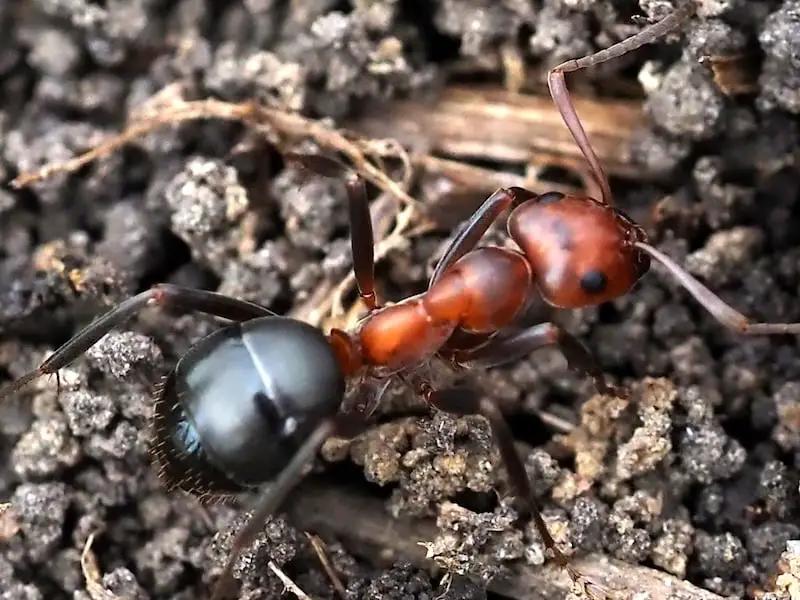
The Allegheny Mound Ant is a large native species that constructs prominent soil mounds across grassy fields, meadows, and forest edges in Missouri. Workers range from 1/8 to 1/4 inch in length, with reddish-orange heads and thoraxes and darker abdomens. Their large, dome-shaped mounds can reach up to three feet in diameter and nearly two feet tall, serving as an important identifying feature. These ants are often seen actively moving around the surface of their mounds on sunny days.
This species is territorial and highly defensive of its nest. When disturbed, Allegheny mound ants aggressively bite intruders but do not sting. Their bite can still be painful due to their strong mandibles. They also spray formic acid as a chemical defense, which can irritate the skin or eyes. Despite lacking a stinger, this acid provides effective protection against predators such as spiders, beetles, and other insects.
Allegheny mound ants primarily feed on honeydew produced by aphids and other sap-sucking insects. They also prey on live insects, contributing to natural pest control in their environment. The workers tend aphid colonies on nearby vegetation, collecting the sugary secretions while protecting the aphids from predators. This mutualistic relationship helps sustain the colony throughout the growing season.
In Missouri, these ants prefer open woodlands, grasslands, and clearings with well-drained soil. They tend to avoid heavily shaded or waterlogged areas. Their large mounds alter local vegetation by killing or damaging plants within several feet of the nest, due to their injection of formic acid into surrounding roots. Despite being beneficial predators, their presence in lawns or gardens can cause aesthetic and ecological changes.
Field Ant (Formica subsericea)
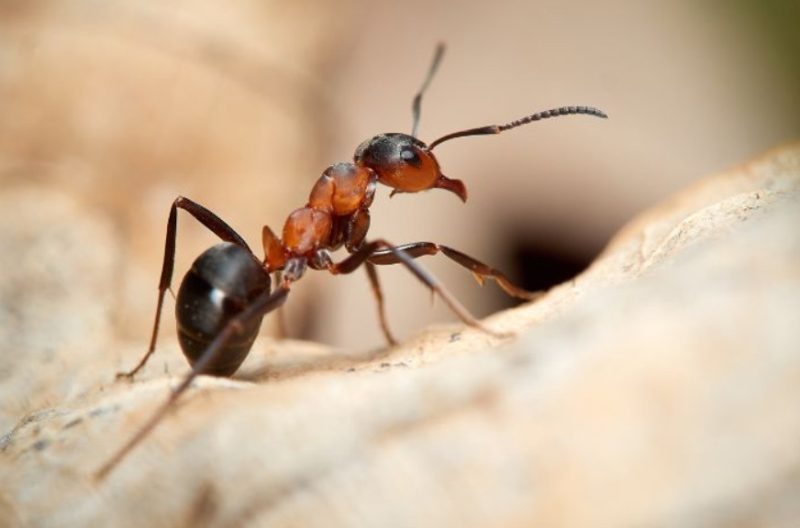
Field ants are among the most common and widespread ant species in Missouri. They are medium to large ants, measuring about 1/4 inch in length, and exhibit a range of colors from black to reddish-brown. Field ants closely resemble carpenter ants but can be distinguished by their smaller size and the presence of a distinct notch on their thorax. Their colonies build mounds of soil or plant material in open areas like fields, meadows, and lawns.
These ants are known for their defensive nature. When threatened, field ants bite and spray formic acid onto the wound, producing a burning sensation. While they do not sting, the bite can be unpleasant, especially when many ants are disturbed at once. Colonies are highly organized, with workers assigned to different tasks including foraging, brood care, and nest maintenance.
Field ants are primarily omnivorous, feeding on honeydew from aphids, plant juices, and small insects. They often farm aphids, protecting them from predators in exchange for sugary excretions. They also scavenge for dead insects and occasionally feed on plant seeds. Their foraging usually occurs during daylight hours, and they are particularly active in the summer months.
These ants prefer open habitats with loose, sandy soil where they can build their large dome-shaped nests. In Missouri, they are commonly found in pastures, parks, and the edges of woodlands. Field ant mounds can sometimes interfere with lawn maintenance, but the species plays a vital ecological role by aerating soil and controlling pest populations.
Carpenter Ant (Camponotus pennsylvanicus)
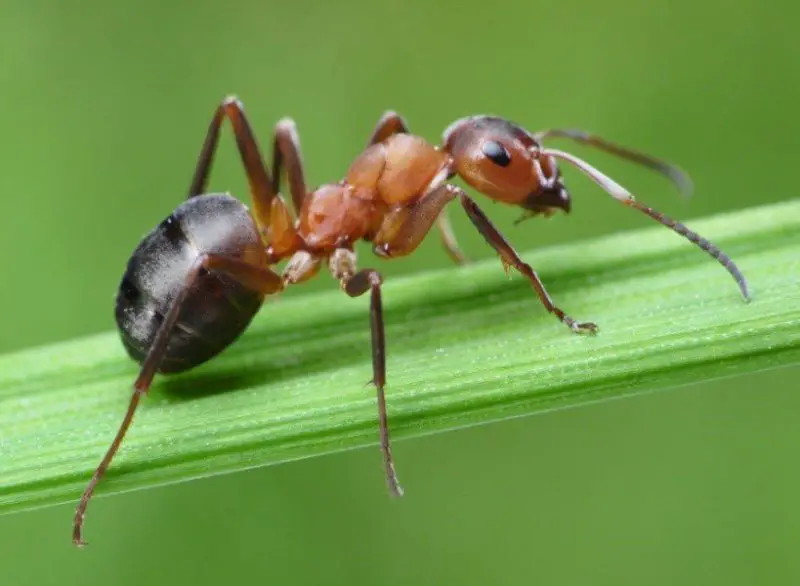
The Carpenter Ant is one of the largest and most recognizable ants in Missouri. Workers range from 1/4 to 1/2 inch long, with a black or dark reddish body and evenly rounded thorax. They have strong mandibles used for chewing wood and defending their nests. These ants are frequently seen indoors and outdoors, especially around decaying wood, fallen logs, or structural timbers in buildings.
Unlike termites, carpenter ants do not eat wood. Instead, they excavate galleries inside wood to create nesting chambers. The resulting sawdust-like debris near their nest entrances is a common sign of infestation. Colonies can contain thousands of individuals and often establish satellite nests away from the main colony. They are mostly nocturnal and can live in both natural and man-made environments.
Carpenter ants feed on a variety of substances, including honeydew, plant juices, and other insects. They often forage along well-defined trails at night, seeking sweet or protein-rich foods. Indoors, they are attracted to sugary spills and food crumbs. While their bite is not venomous, it can be painful due to their powerful jaws, and they may inject formic acid into the wound to enhance the discomfort.
In Missouri, these ants thrive in forests, residential areas, and wooded parks. They prefer moist environments and are commonly found in rotting logs, stumps, and wooden structures. Infestations are most likely in homes with water damage or exposed wood. Regular inspection and moisture control are key to preventing carpenter ant colonies from establishing indoors.
Odorous House Ant (Tapinoma sessile)
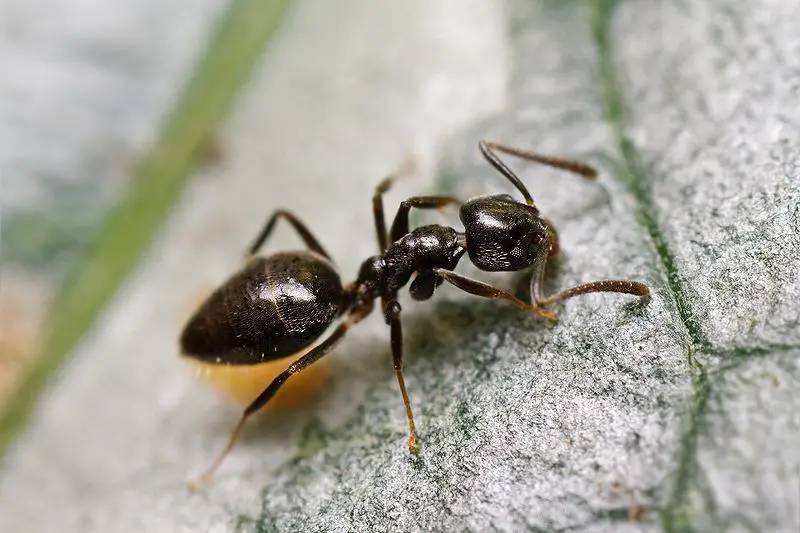
The Odorous House Ant is a small, dark brown species commonly found throughout Missouri. Workers measure about 1/8 inch long, with smooth bodies and uneven thoraxes when viewed from the side. They get their name from the strong, rotten coconut-like odor released when crushed. These ants are one of the most persistent household pests, often forming trails along walls, countertops, and floors.
Despite their small size, odorous house ants form large colonies with multiple queens and interconnected nests. They do not sting, but they can bite weakly. Their colonies are resilient and difficult to eradicate because they frequently relocate nests when disturbed. They can nest both indoors and outdoors, often in wall voids, under floors, or beneath stones and mulch.
These ants are opportunistic feeders, consuming a wide variety of foods. Indoors, they prefer sugary substances like honey, syrup, and fruit juices. Outdoors, they collect honeydew from aphids and feed on dead insects. Workers are active day and night, foraging in long, organized trails between food sources and nesting sites.
Odorous house ants are extremely adaptable and thrive in urban, suburban, and rural environments. In Missouri, they are most active from spring through fall. They prefer moist areas such as kitchens, bathrooms, and near plumbing leaks. While their bites are harmless, their infestations can be a major nuisance. Good sanitation and sealing entry points are essential for prevention and control.
Pavement Ant (Tetramorium immigrans)
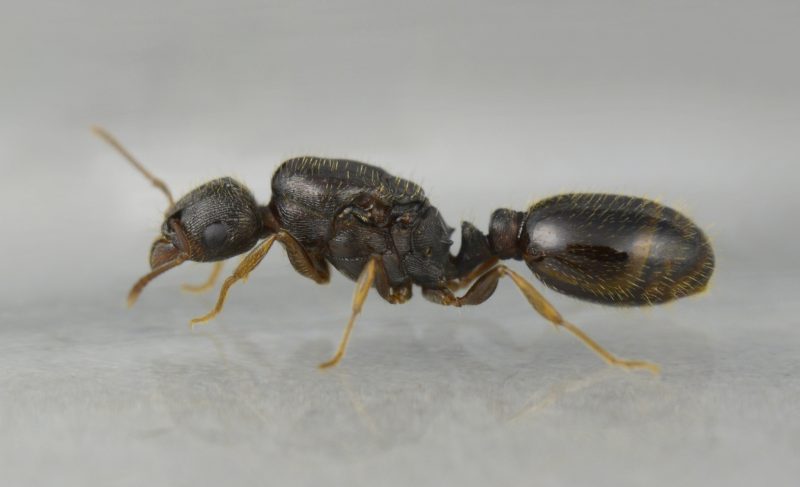
The Pavement Ant is one of the most commonly encountered ants in Missouri, especially in urban and suburban areas. Workers are small, about 1/8 inch long, and have dark brown to nearly black bodies with fine parallel lines running across their heads and thoraxes. Their most distinctive feature is their habit of nesting under sidewalks, driveways, and building foundations, where they push small piles of dirt through cracks in the pavement. This behavior makes their colonies easy to spot during summer months.
These ants are not particularly aggressive, but when disturbed, they will bite and occasionally sting with a mild effect. Their sting is rarely felt by humans, though it can be irritating to sensitive skin. Pavement ants often engage in territorial battles with neighboring colonies, resulting in large swarms of ants fighting on sidewalks or near entry points. These battles are common during spring and early summer when colonies expand.
Pavement ants are omnivores, feeding on nearly anything available. Outdoors, they eat insects, seeds, and honeydew from aphids. Indoors, they are attracted to sugary foods, greasy residues, and crumbs. Their foraging trails can extend long distances from the nest, often appearing along baseboards, countertops, or inside wall voids. Because of their diverse diet, they can easily survive both outdoors and within buildings.
In Missouri, pavement ants are most common in cities like St. Louis, Columbia, and Kansas City, where concrete structures provide ideal nesting conditions. They typically nest in soil beneath sidewalks or patios and may move indoors during cold or rainy seasons. Regular cleaning and sealing cracks are the most effective ways to prevent infestations.
Acrobat Ant (Crematogaster ashmeadi)

The Acrobat Ant is a small to medium-sized species easily identified by its heart-shaped abdomen, which it lifts over its body when threatened—resembling an acrobat balancing upside down. Workers measure about 1/8 inch long and vary in color from light brown to dark brown. These ants are native to Missouri and often nest in decaying wood, tree cavities, and sometimes inside wall voids of homes.
Acrobat ants are aggressive defenders of their nests. When disturbed, they bite and emit a foul odor as a form of defense. Though they do not sting, their bite can cause slight irritation. They often take over abandoned termite or carpenter ant galleries, and their presence can sometimes be mistaken for a termite infestation due to the sawdust and wood debris left behind.
Their diet primarily consists of honeydew, live and dead insects, and plant secretions. They protect aphids and scale insects to harvest honeydew, helping them thrive in both natural and urban environments. Indoors, they are attracted to sweet foods and moisture, often foraging around sinks, bathrooms, and kitchens. Colonies tend to be relatively small compared to those of larger ant species.
In Missouri, acrobat ants are widespread in wooded regions and suburban landscapes. They prefer moist environments such as under logs, rocks, or loose bark. In homes, they can be found nesting near leaky plumbing or damp wood. Regular inspection of wood structures and controlling moisture are important steps in preventing infestations.
Thief Ant (Solenopsis molesta)
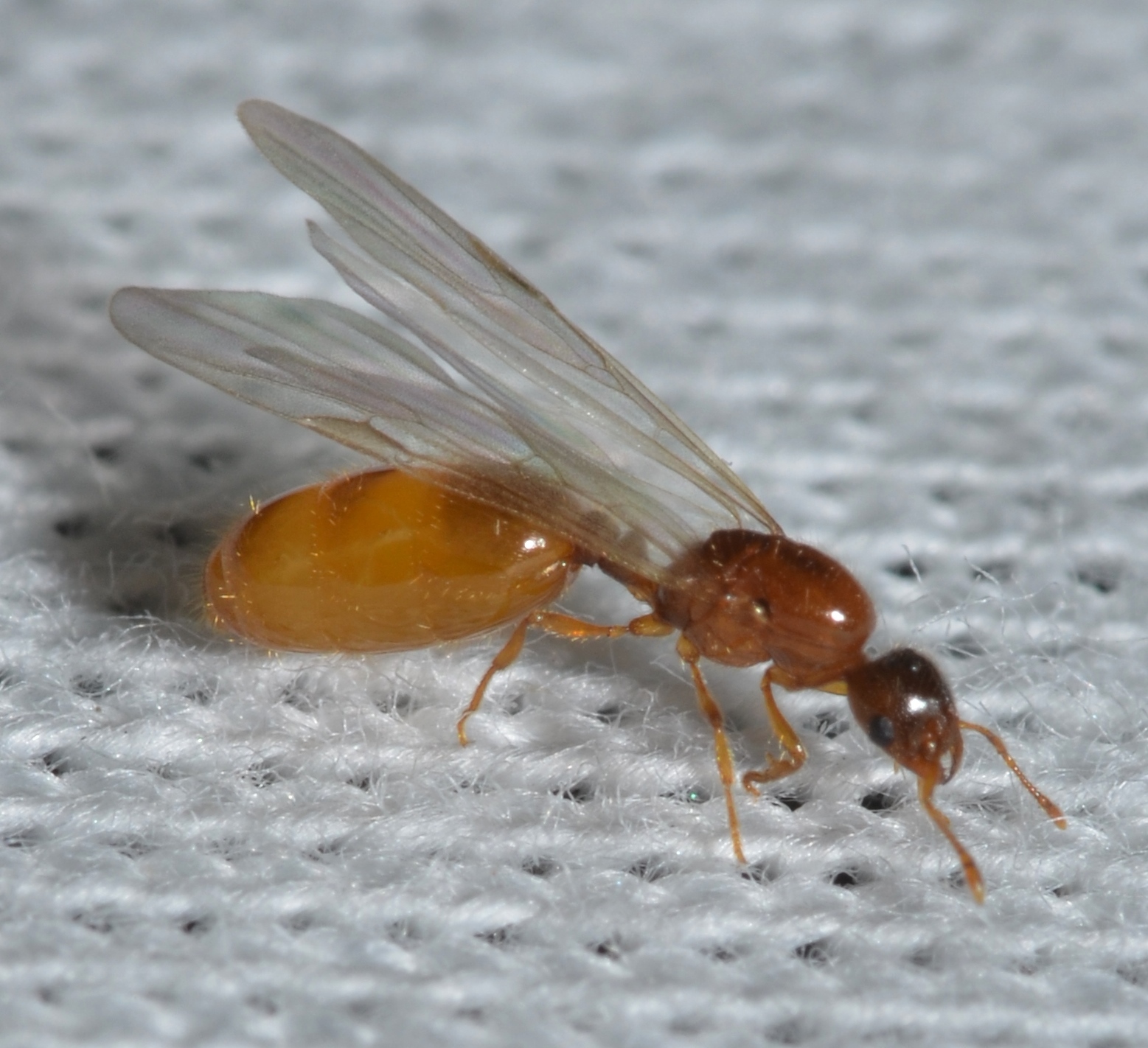
The Thief Ant is one of the smallest ant species found in Missouri, measuring only about 1/16 inch long. Their bodies are pale yellow to light brown, and their tiny size allows them to enter even the smallest cracks in homes or soil. These ants are named for their behavior of nesting near other ant colonies and stealing food or larvae, which gives them the nickname “grease ants.”
Despite their small size, thief ants can bite, though their bite is barely noticeable to humans. They do not sting. These ants are secretive and difficult to locate because their nests are often hidden deep within walls, under floors, or underground. Colonies are small, containing a few thousand workers and several queens, and can relocate easily when disturbed.
Thief ants are omnivorous, preferring protein and greasy foods over sweets. They feed on insect remains, dead animals, and even the brood of other ant species. Indoors, they are attracted to meats, cheese, peanut butter, and oily crumbs. Because they can contaminate food, they are considered a significant pest in kitchens and pantries.
In Missouri, thief ants are found in both rural and urban environments, especially during summer months. They prefer dry, sandy soils for nesting outdoors but often invade homes during hot, dry periods in search of moisture and food. Good sanitation, sealing entry points, and baiting are the most effective control methods.
Large Yellow Ant (Acanthomyops interjectus)
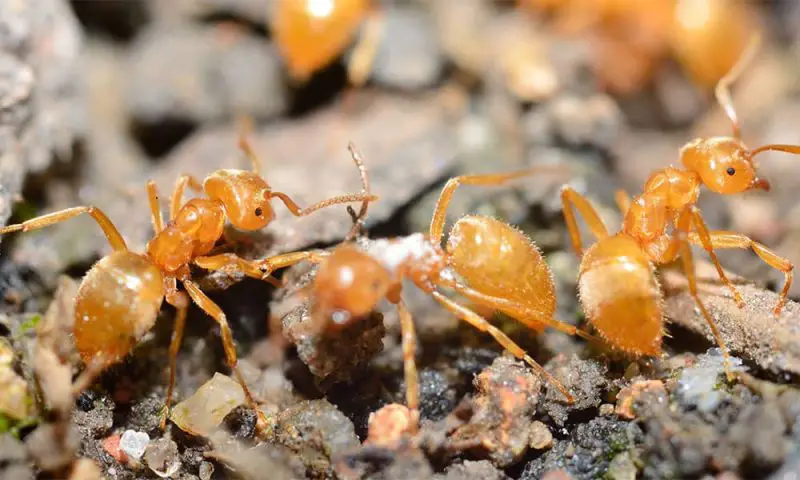
The Large Yellow Ant, also known as the Citronella Ant, is easily identified by its bright yellow to golden-orange coloration and distinctive citrus-like odor when crushed. Workers measure about 1/4 inch long and have smooth, shiny bodies. These ants are subterranean and rarely seen except during mating flights, which occur indoors or outdoors on warm, humid evenings.
Although these ants can bite, they do not sting and are generally non-aggressive. Their bite is weak and harmless to humans. The worker ants spend most of their time underground tending to aphid colonies on plant roots, collecting honeydew as their primary food source. Because of their secretive lifestyle, homeowners often notice them only when winged reproductives emerge from basement cracks or floor edges.
Large Yellow Ants do not feed on household food or damage structures, so they are not considered harmful pests. However, their sudden appearance in homes can be alarming. Swarming typically occurs from late summer through early fall, and the winged ants may be mistaken for termites due to their size and color.
In Missouri, these ants are widespread, favoring well-drained soils in wooded or grassy areas. They nest beneath stones, logs, or foundations. Colonies are long-lived and rarely move. Since they play a role in soil aeration and root ecology, they are generally beneficial outdoors. Control is unnecessary unless large numbers invade indoor areas.
Little Black Ant (Monomorium minimum)
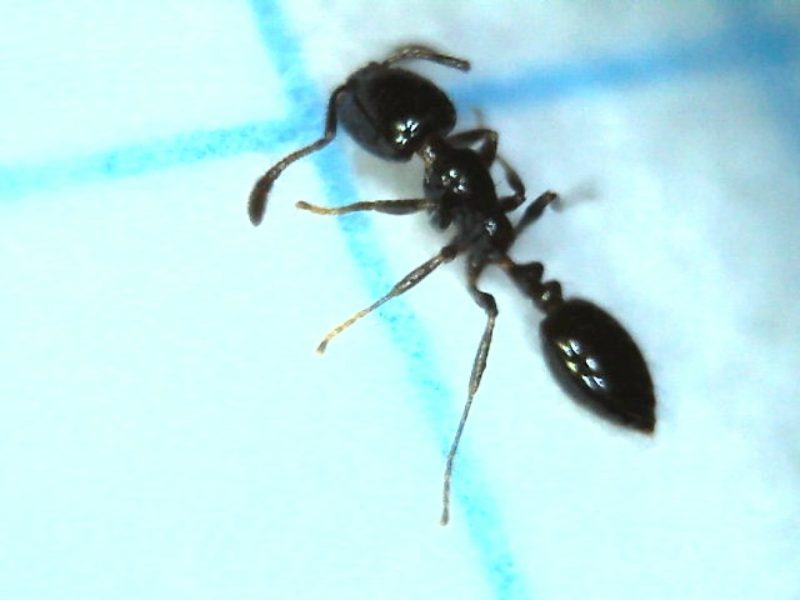
The Little Black Ant is one of Missouri’s most abundant ant species, often seen foraging in large numbers during summer. As their name suggests, they are tiny—only about 1/16 inch long—with shiny black bodies and two-segmented waists. Their small size allows them to enter buildings through tiny cracks, making them a frequent nuisance in homes and businesses.
These ants are not aggressive, but they can bite weakly if handled. They do not sting. Colonies are large, often with multiple queens and interconnected nests spread across wide areas. Workers follow distinct trails when searching for food, which they collect both indoors and outdoors. Their persistence and colony size make them difficult to eradicate completely.
Little black ants feed on a wide range of materials including sweets, grease, proteins, and dead insects. They commonly collect honeydew from aphids and are drawn to sugary spills and food crumbs indoors. Their foraging activity peaks during warm weather, particularly in late spring and summer, when they are most visible along baseboards and kitchen counters.
In Missouri, little black ants are found statewide, thriving in both natural and urban environments. They nest under stones, logs, sidewalks, and the foundations of buildings. Indoors, they prefer wall voids, cracks, and moist areas. Though their bites are harmless, infestations can be bothersome due to their large numbers. Regular cleaning and sealing entry points are the best prevention strategies.
Crazy Ant (Paratrechina longicornis)

The Crazy Ant, named for its erratic and unpredictable movements, is a small but fast-moving ant species commonly found in Missouri. Workers measure about 1/8 inch long, with slender bodies and extremely long legs and antennae. Their bodies are dark brown to black with a faint bluish sheen. These ants move in frantic, irregular patterns when disturbed, distinguishing them from other species with organized foraging trails.
Crazy ants do not sting, but they can bite. Their bites are not painful, though they can be irritating in large infestations. They are known for invading homes, hospitals, and warehouses, especially in search of moisture or food. Colonies are large and have multiple queens, which makes them resilient and capable of rapid population growth.
Crazy ants are omnivorous, feeding on live and dead insects, honeydew, sweets, and greasy materials. Outdoors, they farm aphids and mealybugs to harvest honeydew, while indoors they are attracted to sugary and oily foods. Their foraging trails are often seen along walls, electrical outlets, or under carpets, and they are active both day and night.
In Missouri, crazy ants thrive in warm, humid environments. They often nest in potted plants, under rocks, inside electrical boxes, or within wall voids. While they are less common in colder regions of the state, their adaptability allows them to survive indoors year-round. Their infestations can be particularly troublesome due to their attraction to electronics and their ability to cause short circuits.
Cornfield Ant (Lasius neoniger)
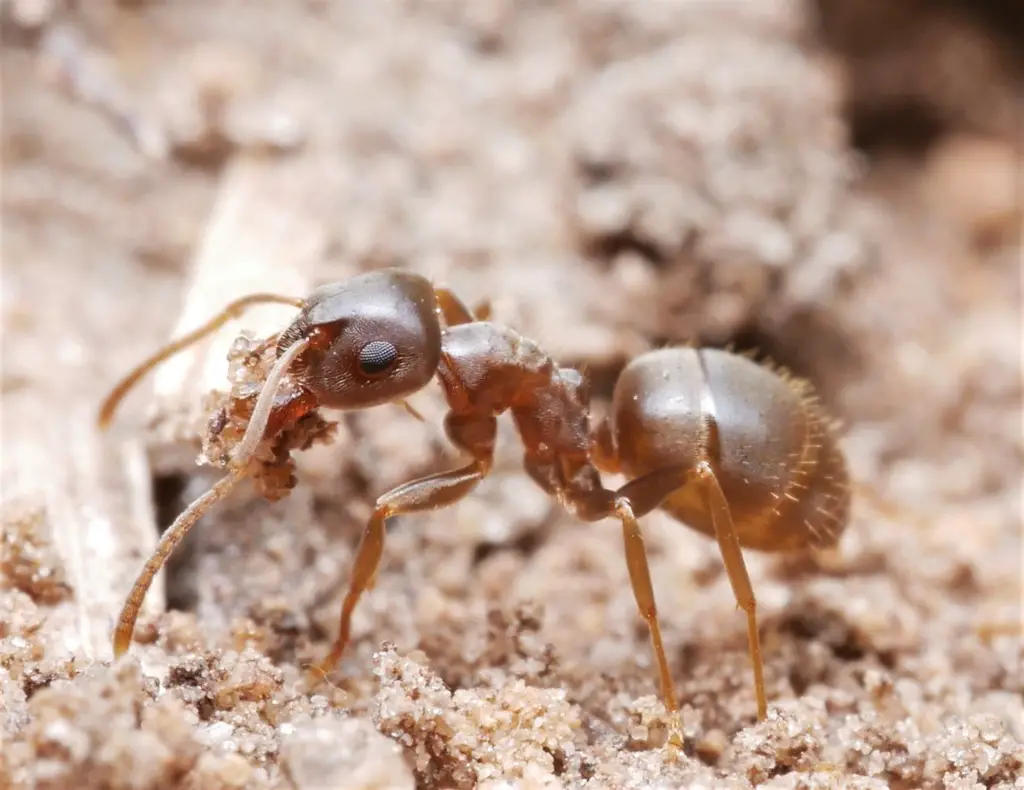
The Cornfield Ant is one of the most abundant ant species in Missouri’s agricultural and suburban areas. Workers measure about 1/8 inch long, with yellowish-brown to reddish-brown bodies and slightly darker abdomens. They are commonly seen constructing small, flattened soil mounds in open grassy fields, lawns, and along sidewalks, especially after rainfall. These mounds often have a single central entrance and can number in the hundreds in large colonies.
Cornfield ants are not aggressive toward humans. They lack a stinger and rarely bite unless provoked, and even then, their bite is mild and harmless. Their colonies are typically small to medium in size, led by a single queen. They are highly social insects, working collectively to maintain their nests and care for the brood.
Their diet mainly consists of honeydew from aphids, plant secretions, and small insects. They play an important ecological role by aerating soil and helping decompose organic matter. Indoors, they occasionally invade homes in search of sweets but do not pose any significant health risks. They are most active during the warmer months and hibernate underground during winter.
In Missouri, cornfield ants are widely distributed in both rural and urban environments. They prefer well-drained soil and sunny areas such as lawns, pastures, and golf courses. Their presence often indicates healthy soil structure. Because they rarely cause damage, they are generally considered beneficial insects rather than pests.
Harvester Ant (Pogonomyrmex barbatus)
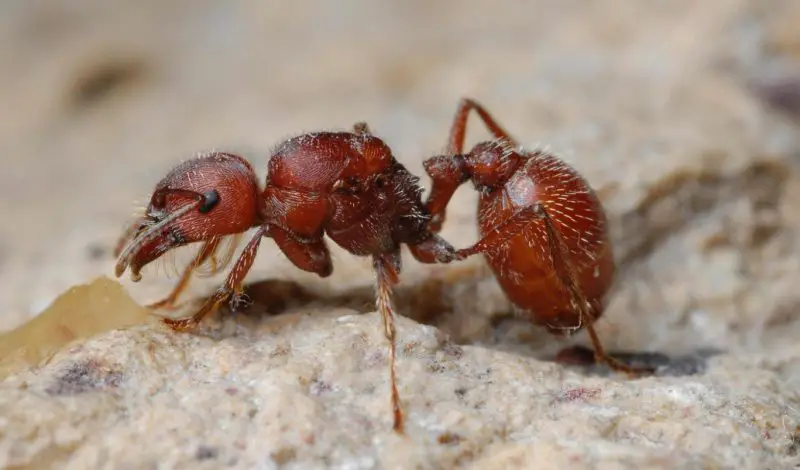
The Harvester Ant is one of the larger and more conspicuous ant species found in Missouri, particularly in dry, open habitats. Workers range from 1/4 to 1/2 inch long, with reddish-brown bodies and large heads equipped with strong mandibles. They are named for their habit of collecting seeds, which they store in underground chambers as their primary food source. Their nests are often surrounded by cleared circular areas devoid of vegetation.
These ants are known for their potent sting, which is among the most painful of all North American ants. The sting delivers venom that causes burning, swelling, and in rare cases, allergic reactions. They use their sting primarily for defense, especially when their nest is disturbed. Unlike fire ants, however, they do not attack in large numbers and usually sting only when directly threatened.
Harvester ants feed primarily on seeds but will also consume dead insects for protein. They are vital for seed dispersal and soil enrichment, playing a key ecological role in maintaining native grassland ecosystems. Foraging occurs during the day, with workers traveling long distances from the nest to collect food. They rely heavily on visual cues to navigate back to their nests.
In Missouri, harvester ants are most often found in the southern and central regions, inhabiting dry fields, prairies, and sparsely vegetated areas. Their mounds are usually large, dome-shaped, and located in sunny spots with sandy or loamy soil. Because of their painful sting, caution is advised when walking barefoot or working near their colonies.
Twig Ant (Pseudomyrmex gracilis)
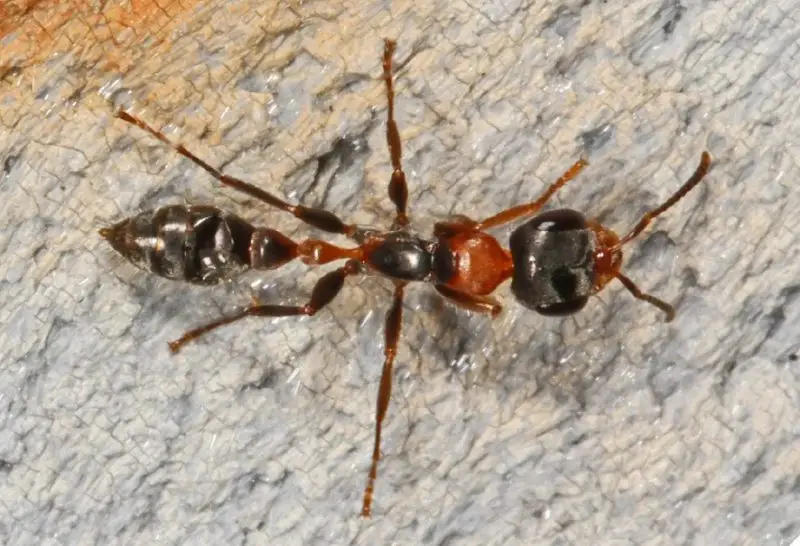
The Twig Ant, also known as the Elongate Twig Ant, is a slender, wasp-like species that can be found in southern parts of Missouri. Workers measure about 1/4 inch long, with elongated bodies, narrow waists, and large eyes. Their coloration varies from brownish-orange to dark brown, and their long legs and rapid movements make them easy to mistake for small wasps.
These ants are capable of delivering a painful sting, though they generally do not attack unless provoked. Their sting contains venom that causes localized pain and swelling but is not medically significant. Twig ants are arboreal, nesting inside hollow twigs, dead branches, and tree cavities rather than in soil. They are skilled climbers and spend most of their time on trees and shrubs.
Their diet consists mainly of small insects, nectar, and honeydew collected from sap-sucking insects. They play a beneficial role in controlling pest populations and pollinating certain flowering plants. Twig ants are active during warm months, especially from late spring through early fall, when they can be seen foraging along tree trunks and foliage.
In Missouri, twig ants inhabit wooded areas, gardens, and parks with abundant vegetation. They prefer warm, humid conditions and are more common in southern counties. While their stings can be unpleasant, they are not aggressive toward humans unless their nests are disturbed. Maintaining trimmed vegetation near homes can help minimize encounters.
Velvet Tree Ant (Liometopum occidentale)
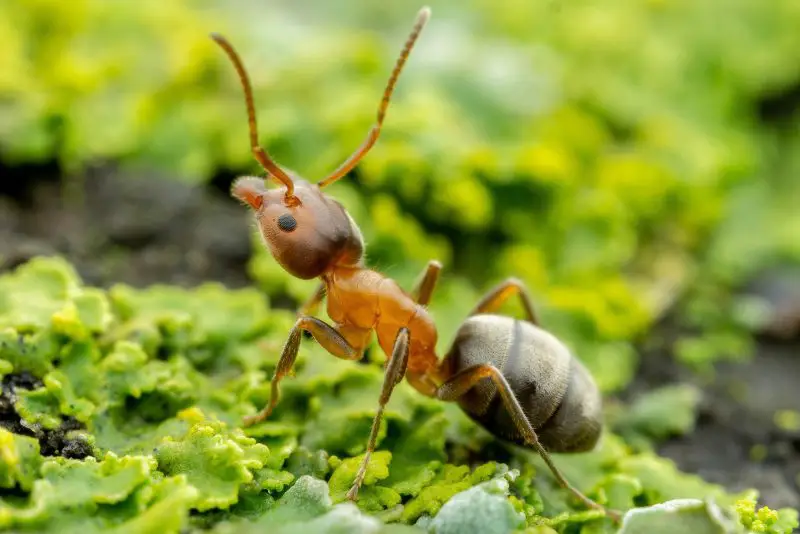
The Velvet Tree Ant is a large, striking species known for its velvety appearance and potent bite. Workers measure about 1/4 inch long and have shiny black or dark brown bodies with fine, velvety hairs. Their thorax is smoothly curved, and they emit a distinctive odor when crushed. Although native to the western United States, isolated populations have been recorded in southern Missouri, often introduced through landscaping materials or wood transport.
Velvet tree ants are aggressive defenders of their nests. They do not sting but deliver a painful bite and spray formic acid onto the wound, which can cause a burning sensation. This chemical defense makes them formidable opponents against predators and other insects. They are also territorial and will fiercely protect their nesting sites from intruders.
Their diet consists primarily of honeydew from aphids, plant sap, and dead insects. They are strong foragers and often form long trails up tree trunks and along fences. Unlike some other ants, they prefer to build their nests above ground in tree cavities, under bark, or within decaying wood. They may occasionally enter homes in search of food or shelter during dry or cold periods.
In Missouri, velvet tree ants are found in forested and park-like environments with plenty of trees and moisture. They prefer warm, sheltered habitats and are most active from late spring through early autumn. Their presence can sometimes be mistaken for carpenter ants, but their velvety sheen and pungent odor set them apart. While not a major pest, they can become a nuisance in outdoor recreational areas.
Tips for Dealing with Biting Ants in Missouri
1. Keep Your Yard and Home Clean
Biting ants are attracted to food sources and moisture. Regularly clean kitchen surfaces, seal trash cans, and store food in airtight containers. Outdoors, keep your lawn trimmed and remove fallen wood or debris that may serve as nesting sites. Clean up pet food and spilled bird seed, as these are common ant attractants.
2. Seal Entry Points and Cracks
Inspect your home’s foundation, doors, and windows for gaps or holes that ants can use to enter. Use silicone caulk or weather stripping to seal these areas. Pay close attention to spaces where utility pipes and wires enter the house, as ants frequently use these as access points.
3. Eliminate Standing Water
Many ant species, including crazy ants and odorous house ants, are drawn to moisture. Fix leaky faucets, pipes, and air-conditioning units. Avoid overwatering lawns or garden beds, and ensure proper drainage around your property.
4. Use Bait Stations Strategically
Ant baits are effective for controlling colonies, as they allow worker ants to carry poison back to the nest. Place bait near ant trails, behind appliances, or along baseboards. Be patient—colonies may take several weeks to collapse completely. Avoid spraying insecticide directly on the trails, as it can repel ants from the bait.
5. Manage Outdoor Nest Sites
If you notice mounds or ant activity around sidewalks or foundations, treat them with ant bait granules or mound drenches. For large colonies such as fire ants or harvester ants, professional pest control may be necessary. Avoid disturbing mounds directly, as this can trigger mass attacks.
6. Maintain a Regular Pest Control Schedule
Preventing ants from reestablishing is easier than eliminating them after infestation. Schedule regular pest control inspections, especially during warm months. Early detection can prevent colonies from spreading indoors.
FAQs about Biting Ants in Missouri
What are the most aggressive biting ants in Missouri?
The Red Imported Fire Ant is considered the most aggressive and dangerous biting ant in Missouri. It both bites and stings, delivering painful venom that can cause blisters and allergic reactions. Other species, such as harvester ants and velvet tree ants, also inflict painful bites but are less likely to attack unless provoked.
Can Missouri ants sting or are they only biters?
Most Missouri ants bite rather than sting. However, species like the Red Imported Fire Ant and Harvester Ant can sting using venomous stingers. Others, such as carpenter ants and field ants, rely on strong mandibles and formic acid sprays to defend themselves.
How can I tell if I have biting ants or just nuisance ants?
Biting ants are often larger and more territorial than harmless house ants. Look for signs like painful bites, large mounds in your yard, and visible foraging trails. Fire ants, for instance, build raised mounds in open areas, while carpenter ants are often found near damp or decaying wood.
Are biting ants dangerous to pets or livestock?
Yes. Fire ants and harvester ants can be harmful to pets and livestock if they are bitten multiple times. Their venom can cause swelling, irritation, and, in severe cases, allergic reactions. Animals that disturb mounds may be attacked by hundreds of ants simultaneously.
When are biting ants most active in Missouri?
Most biting ants are active from late spring through early fall, when temperatures are warm. Activity peaks after rain, as soil moisture encourages foraging and nest expansion. During winter, colonies retreat underground and become dormant.
How can I control biting ants naturally?
Natural control methods include sprinkling diatomaceous earth around entry points, pouring boiling water into small mounds, or using a vinegar and water solution to disrupt scent trails. Maintaining a dry, clean environment reduces their attraction to your property.
Do ant bites require medical treatment?
Most bites cause minor irritation, redness, or itching that can be treated with soap, water, and ice. However, severe swelling or allergic symptoms such as difficulty breathing require immediate medical attention. Fire ant stings are the most likely to trigger allergic reactions.
Can ants damage my home or property?
Yes, certain species such as carpenter ants can cause structural damage by hollowing out wood to build nests. While they do not consume wood like termites, their tunnels weaken wooden structures over time. Regular inspection of wooden beams and window frames is recommended.
Are all ants with large mounds dangerous?
No, not all mound-building ants are dangerous. For example, the Allegheny Mound Ant builds large nests but relies on biting and formic acid spray rather than stinging. However, any ant mound should be approached cautiously until the species is identified.
What should I do if I get bitten by an ant?
Immediately wash the affected area with soap and water to reduce infection risk. Apply a cold compress to ease pain and swelling. Over-the-counter antihistamines or hydrocortisone creams can help relieve itching. If multiple bites or allergic symptoms occur, seek medical assistance promptly.




